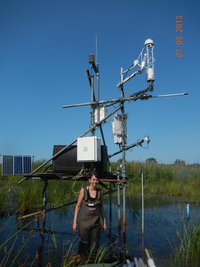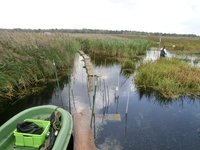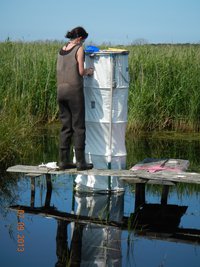Research in the Hüttelmoor
Modeling of area-related substance flows based on gas flow measurements (closed chamber) over spatial patterns of the vegetation
Continuation ofDFG Projektes (2010- 2013)
Gas flows and thus material budgets in ecosystems play an important role in assessing the climate relevance of land use types with regard to the predicted climate change. Gas dome measurements and eddy covariance measurements are the two methods used to detect them. Both methods have been tested but have not been conclusively discussed.
Gas hood measurements are associated with a high spatial and temporal variability. On the one hand, this is due to the seasonal developments in ecosystems and, on the other hand, to the spatial variability of the plant cover and the microorganism communities associated with it. In the intended project, the composition of the vegetation in a heavily degraded, saltwater-influenced, rewetted fen on the Baltic Sea coast is to be used in order to transfer gas hood measurements arranged in a regular grid to the area.
For this purpose, the vegetation is recorded using a regular, equidistant grid of recording areas, the connection between rivers and vegetation is analyzed (geographically weighted regression, regression kriging, other multivariate and geostatistical methods) and with the help of remote sensing and other environmental data obtained on site (water level , salinity in the bottom water, etc.) modeled the areal distribution of the gas flows. This can be of great importance for areal statements on CO2 and CH4 fluxes.



